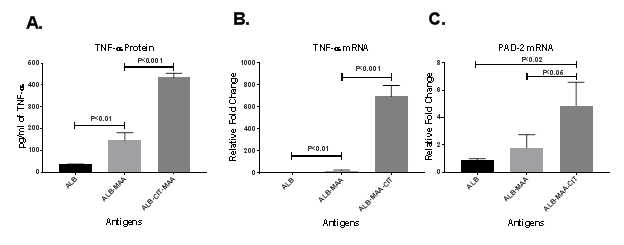Session Information
Date: Sunday, November 5, 2017
Title: Rheumatoid Arthritis – Human Etiology and Pathogenesis Poster I
Session Type: ACR Poster Session A
Session Time: 9:00AM-11:00AM
Background/Purpose: We have previously shown that malondialdehyde-acetaldehyde (MAA) and citrullinated proteins are present together in the synovial tissues of rheumatoid arthritis (RA) patients. Macrophage are a major source of not only TNF-α, but also PAD enzymes and are both involved in the progression of RA. MAA adducts and citrullinated proteins alone have the ability to increase TNF-α release in many different cell types. Therefore, the objective of this study was to determine if proteins modified with both MAA and citrulline increase the expression and secretion of both PAD and TNF-α in a human monocytic cell line.
Methods: THP-1 cells were grown and activated with PMA. Following serum starvation the cells were incubated with either 50 µg/ml of human albumin (ALB), ALB-MAA, ALB-Citrulline (CIT) and ALB-MAA-CIT for 4 hours. Supernatants were collected and assayed for TNF-α protein by a commercial ELISA kit. RNA was extracted from the cells and subjected to RT-PCR for expression of PAD-2, PAD-4, and TNF-α.
Results: Human monocytic cells exposed to ALB-MAA significantly increased levels of TNF-α protein from 35.5 ± 0.75 pg/ml to 146.8 ± 33.55 pg/ml compared to ALB alone (P<0.01) (A). The addition of ALB-MAA-CIT significantly increased the secretion 435.5 ± 17.88 pg/ml (P<0.001) when compared to ALB-MAA (A). Cells incubated with ALB-MAA-CIT showed and increased expression of TNF-α mRNA by 6 fold (698.6 ± 96.62 RQ) compared to MAA-ALB (20.09 ± 6.48 RQ) (P<0.001) (B). PAD-2 mRNA was increased following exposure to both ALB-MAA (1.79 ± 0.96 RQ) and ALB-MAA-CIT (4.87 ± 1.71 RQ) (compared to each other (P<0.05), although only the latter achieved statistical significance compared to ALB alone (P<0.02) (C). No increase in PAD-4 mRNA was detected in any of the groups. Additionally, results from the stimulation by ALB-CIT were not different that ALB alone.
Conclusion: We and others have shown that MAA-modified proteins and citrullinated proteins alone can activate macrophages to release TNF-α. Until now, no studies have reported on the effects of these modified protein moieties commonly found in RA. The significantly increased expression of TNF-α and PAD-2 mRNA in human macrophages following exposure to ALB-MAA-CIT, supported by the clinical observation that these protein(s) are found together in synovial tissues strongly suggests a role in the pathogenesis of RA.
To cite this abstract in AMA style:
Duryee LM, Duryee MJ, Clemens DL, Ryan EM, Hunter CD, Klassen LW, O'Dell JR, Anderson DR, Mikuls TR, Thiele GM. Increased Expression of TNF-α and PAD-2 in Human Monocytes Following Treatment with Protein Modified with Malondialdehyde-Acetaldehyde (MAA) and Citrulline [abstract]. Arthritis Rheumatol. 2017; 69 (suppl 10). https://acrabstracts.org/abstract/increased-expression-of-tnf-%ce%b1-and-pad-2-in-human-monocytes-following-treatment-with-protein-modified-with-malondialdehyde-acetaldehyde-maa-and-citrulline/. Accessed .« Back to 2017 ACR/ARHP Annual Meeting
ACR Meeting Abstracts - https://acrabstracts.org/abstract/increased-expression-of-tnf-%ce%b1-and-pad-2-in-human-monocytes-following-treatment-with-protein-modified-with-malondialdehyde-acetaldehyde-maa-and-citrulline/

